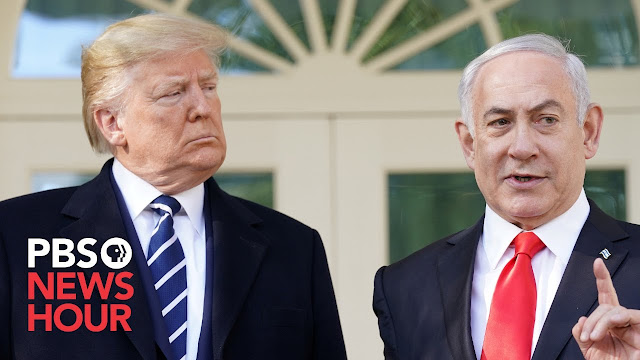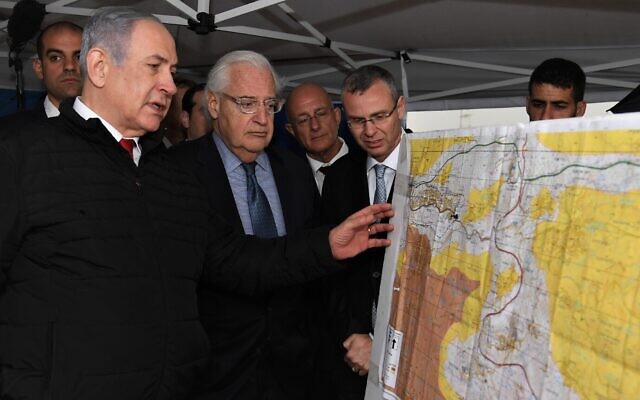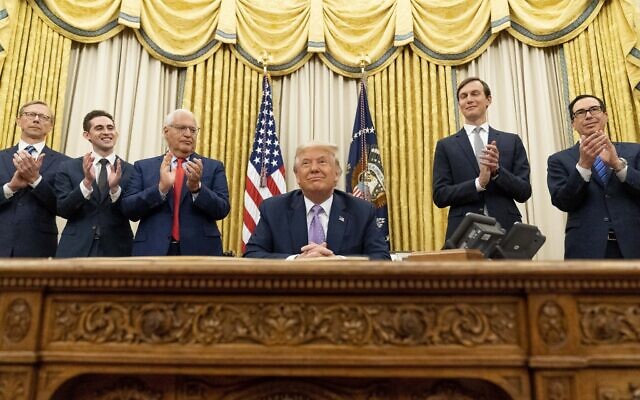Book tells of Jared Kushner’s fury at Israeli PM’s unexpected declaration, an exasperated Trump snapping, ‘If you want to do it, do it,’ and Netanyahu’s cold feet before UAE deal.
By TOI STAFF
Then-US president Donald Trump, right, looks over to then-prime minister Benjamin Netanyahu, left, during an event in the East Room of the White House in Washington, January 28, 2020, at which Trump unveiled his 'Peace to Prosperity' vision for an Israeli-Palestinian accord. (AP/Susan Walsh)
In January 2020, during a festive White House unveiling of Donald Trump’s long-gestating peace plan, then-Israeli prime minister Benjamin Netanyahu giddily announced that under its auspices, Israel would move to immediately annex large parts of the West Bank.
The Israeli right was ecstatic. Finally, they believed, Israel would take full control of land that settler leaders hope will remain forever Israeli — and with the blessing of a US president, no less.
There was only one problem, according to new reporting on the events of those dramatic days: Nobody had bothered asking the president in question.
In fact, according to a new book from Israeli journalist Barak Ravid, Trump and peace-plan architect Jared Kushner were caught completely off guard by Netanyahu’s declaration during the White House event.
The new details were reported in a pair of podcast episodes released Monday in a new series from Axios called “How It Happened,” which uses Ravid’s reporting from his new Hebrew book, “Trump’s Peace,” to tell the story of how Trump’s failed peace plan morphed into the successful brokering of the Abraham Accords.
According to the podcast, Netanyahu decided to go forward with the annexation announcement after receiving assurances from then-US ambassador to Israel and longtime settlement-backer David Friedman that the US would back the move, even though the envoy never ran the idea by the White House.
The US proposal envisioned Israel annexing all of its settlements along with the Jordan Valley as part of a final status agreement. But it did not give a clear timeline, and it definitely did not stipulate that the move would take place right off the bat.
“Israel will apply its laws to the Jordan Valley, to all Jewish communities in Judea and Samaria, and to other areas that your plan designates as part of Israel and which the US agrees to recognize as part of Israel,” Netanyahu said.
Trump was standing right behind him and glanced at someone off stage, checking to make sure what he had just heard, Ravid recalled. After Netanyahu left the White House, Trump met with his advisers and asked them, “What the hell was that?”
Kushner, meanwhile, was livid.
The perfect platform
Going back to the peace plan’s earlier stages, Ravid began by sharing the story of how Kushner became tasked with handling the Israeli-Palestinian peace file. Ahead of his inauguration, Trump held a briefing with The New York Times, during which he told them of the decision, despite never having given Kushner the heads-up.
Kushner would go on to joke that Trump gave him the job because he must not like him very much.
Less than a year into the administration, after Trump had met with both Netanyahu and Palestinian Authority President Mahmoud Abbas, the president made the decision in 2017 to officially recognize Jerusalem as Israel’s capital.
Kushner notified a visiting PA delegation led by the late Palestinian negotiator Saeb Erekat of the decision in December 2017. Erekat was shocked and warned him that the move would disqualify the US as a peace broker and risked plummeting the region into violence, Ravid said. Kushner did not take the criticism well, and shouted back at Erekat that he would not be threatened.
Palestinian Authority President Mahmoud Abbas, right, meets US President Donald Trump In the West Bank city of Bethlehem on May 23, 2017. (Fadi Arouri, Xinhua Pool via AP)
Trump himself later phoned Abbas to update him personally of the decision and tried during the call to calm him down, assuring the PA leader that Ramallah would get its own gesture from Washington next. But after rambling for several minutes, Trump noticed that Abbas had hung up on him, Ravid said. That would be the last time the two leaders would ever talk.
Trump would go on to exact his own form of revenge in response to the PA’s refusal to engage with US peace efforts, cutting virtually all aid to the Palestinians, shuttering the PLO diplomatic office in Washington, and closing the US consulate in Jerusalem that historically had served as the de facto mission to the Palestinians.
Netanyahu, meanwhile, cozied up to Trump, seeking to capitalize on Trump’s anger toward the Palestinians and interest in pleasing his evangelical base. This paid dividends for the Israeli leader in the form of the US withdrawal from the Iran nuclear deal in May 2018, the opening of the US embassy in Jerusalem that same year, and Trump’s recognition of Israeli sovereignty over the Golan Heights in March 2019, just weeks before an election in Israel. (Trump told Ravid in a newly released interview that he had recognized the Golan in part because he wanted to help Netanyahu in the vote. But Netanyahu failed to secure a ruling majority and Israel was plunged into two years of political chaos and three more elections.)
Netanyahu then began considering taking Trump’s apparent generosity a step further, seeking US support for a plan to annex large parts of the West Bank. The move was a nod to the settler movement, which Netanyahu had increasingly come to rely on amid the snowballing corruption cases against him.
When the Trump administration began coalescing its peace plan in 2019, Netanyahu saw it as a platform for his annexation announcement, Ravid revealed on the Axios podcast. Netanyahu was further emboldened by Friedman, who assured the Israelis that Trump would be fine with the controversial move. But Ravid said that the ambassador never ran the idea by Trump and Kushner, who were opposed to it, concerned that it would tank their plan.
Then-prime minister Benjamin Netanyahu (L) and then-US ambassador to Israel David Friedman (2nd-L) at the northern West Bank settlement of Ariel on February 24, 2020. (David Azagury/US embassy Jerusalem)
Friedman disputes Ravid’s account. He tweeted Sunday that “not only was the president informed and aware of the sovereignty process, he outlined it in this speech. There were numerous follow-up discussions as well, all of which included me. A book on this subject on which I was never consulted should be taken with a grain of salt.”
Still unaware of Trump’s opposition to annexation, Netanyahu arrived in Washington for the January 28, 2020, unveiling ceremony of the US peace plan, and made his big announcement.
One Trump aide told Ravid that Netanyahu turned the US leader into a “potted plant” during that “campaign” speech, when the president thought the Israeli premier would use the opportunity to make a gesture toward the Palestinians.
Shortly after the ceremony, Netanyahu met with reporters at Blair House, where he was staying, and told them that he planned to bring the annexation move before the cabinet for approval within days.
But around the same time, Kushner called Friedman into his office, where he dressed down the envoy for convincing the Israelis that the US would support the annexation plan. He then ordered Friedman to go across the street to Blair House and inform the prime minister that the US would not accept such a move, Ravid said.
Netanyahu was made to understand that a US greenlight for annexation had not been given, and had no choice but to delay the process in the Israeli government — though he continued to insist the move would soon happen.
A month went by with very little contact between the Israelis and Americans. Then one day, Israel’s ambassador to the US at the time, longtime Netanyahu confidant Ron Dermer, paid a visit to Kushner, and blamed the White House for embarrassing the prime minister over the annexation saga, Ravid recounted.
Kushner pushed back, insisting that no US president had done more for Israel. Dermer then told Kushner that Netanyahu did not know whether he could trust the Trump administration anymore. At that point, Kushner lost his cool and threw the Israeli ambassador out of his office.
Then-prime minister Benjamin Netanyahu (L) and then-US ambassador to Israel David Friedman (2nd-L) at the northern West Bank settlement of Ariel on February 24, 2020. (David Azagury/US embassy Jerusalem)
‘If you want to do it, do it’
Still determined to move forward with the annexation plan, Netanyahu negotiated the matter into his coalition agreement with Blue and White chairman Benny Gantz after the March 2020 election. The premier even set a timeline for the move, vowing to begin carrying it out on July 1 of that year.
At that point though, the only one pulling for the move in the Trump administration was Friedman, who decided to fly to Washington a week before the July 1 deadline to lobby the president, Ravid reported.
The meeting did not go well at all for Friedman though, with Trump using the opportunity to complain about the speech Netanyahu gave at the peace plan’s unveiling. Friedman tried to interrupt, but Trump responded, “David, why are we even talking about this,” according to the Axios podcast.
The president again insisted that he had already done more for Israel than any of his predecessors before quickly losing his patience and saying, “If you want to do it, do it,” and adding that his secretary of state Mike Pompeo would be the one to decide.
But before Friedman left, Trump warned, “You should know though that if anything happens, it’s on all of your heads.” Ravid said this last remark shook Friedman, who did not want to be responsible for what might come next.
Kushner subsequently dispatched Friedman along with White House peace envoy Avi Berkowitz to Jerusalem in order to convince Netanyahu not to go through with the annexation plan.
The meetings took place during the height of the first wave of the coronavirus pandemic. At their meeting, Netanyahu sat behind a glass divider that Berkowitz told Ravid “was something out of science fiction.”
Friedman at one point left the room, at which point Berkowitz piped up, “I’m not sure what David told you, but the meeting with the president regarding annexation went really badly.”
Berkowitz urged Netanyahu not to go forward with the move, and said that if the premier insisted, it would have to be done alongside a series of significant gestures to the Palestinians. This further angered Netanyahu, who threatened to go ahead and carry out the move unilaterally, Ravid reported.
The US envoy said that the prime minister was free to do so, but that he should be aware that it could lead Trump to tweet against Netanyahu, and he could lose the president’s support.
Avi Berkowitz, left, then-US president Donald Trump’s special representative for international negotiations, leaves the US mission to the United Nations after attending a luncheon for members of the Security Council, February 7, 2020, in New York. (AP Photo/Mark Lennihan)
“You’re going to take your greatest friend in the world, and make him an enemy. I can’t tell you what to do but I strongly advise you against it,” Ravid quoted Berkowitz as having told Netanyahu.
A solution takes shape
After two meetings between Netanyahu, Friedman and Berkowitz in which the sides made no progress, Berkowitz called Kushner, and the two decided to offer Netanyahu a carrot in exchange for shelving annexation.
Back in March 2019, United Arab Emirates Ambassador to the US Yousef al-Otaiba had paid a visit to Kushner’s home in Washington. There he told Trump’s senior adviser that the UAE wanted to normalize ties with Israel.
With that meeting in mind, Kushner told Berkowitz to offer the UAE proposal in exchange for Netanyahu dropping annexation.
Netanyahu responded that he would consider the proposal, but insisted that he was not ready to drop annexation entirely.
Berkowitz flew back to Washington and headed straight to the White House to update Kushner. While on the way, the envoy got a call from Otaiba who suggested the exact same exchange — normalization for shelving annexation.
Then-US president Donald Trump, accompanied by (from left), then-US special envoy for Iran Brian Hook, Avraham Berkowitz, then-assistant to the president and special representative for international negotiations, then-US ambassador to Israel David Friedman, Trump’s White House senior adviser Jared Kushner, and then-treasury secretary Steven Mnuchin, applauding in the Oval Office at the White House, August 12, 2020, in Washington. (AP Photo/Andrew Harnik)
Berkowitz called the conversation “a godsend, one of the best phone calls I’ve ever had in my life,” in an interview played on the Axios podcast.
The US envoy told Otaiba that he just so happened to have thought of the same proposal. The Israelis, the Emiratis, and the Americans would subsequently launch marathon negotiations on the matter. Ravid noted that the Emiratis never negotiated directly with the Israelis, as Abu Dhabi wanted to be sure that the Israeli commitments were being made to the US, not the UAE, evidently not entirely convinced of Netanyahu’s sincerity.
The sides managed to make progress, but the talks nearly blew up several times, including once when Dermer told Berkowitz that Netanyahu would only drop annexation if three Arab countries agreed to normalize ties with Israel, not just one.
Berkowitz passed along the message to Kushner, who was furious. “He’s only going to get one country, and if he doesn’t want it, he can just go fuck himself,” Ravid quoted Trump’s son-in-law as saying.
Berkowitz went back to Dermer and said, “I’ll tell you gently, take what you’re offered.”
Emirati Ambassador to the US Yousef al-Otaiba at an event with then-US House speaker Paul Ryan, at the Emirates Diplomatic Academy, in Abu Dhabi, United Arab Emirates, January 25, 2018. (AP/Jon Gambrell)
Eventually, the sides appeared to move past all their differences and a date was set for the public announcement on August 13, 2020.
Ravid said that on the day before, Netanyahu got cold feet and had Dermer call the White House to notify them that the prime minister would not be signing the agreement.
Not having any of it, Friedman — who had already flown to Washington for the big day — called Netanyahu, screaming, “It’s happening tomorrow. You don’t have a choice.” The pep-talk appeared to work as Netanyahu got back on board.
On the day of the announcement, the White House was still working on coming up with a name for the normalization agreement, Ravid said. It was National Security Council staffer Miguel Correa who came up with “The Abraham Accords,” in reference to the biblical father of both Judaism and Islam. The idea was brought to Trump, who joked that the “Trump Accords” would be better, but that he would agree to their idea as well.
Former Israeli prime minister Benjamin Netanyahu, former US president Donald Trump, and United Arab Emirates Foreign Minister Abdullah bin Zayed al-Nahyan, sit during the Abraham Accords signing ceremony on the South Lawn of the White House, in Washington, on September 15, 2020. (AP Photo/Alex Brandon, File)
Hours later, a conference call took place between Trump, Netanyahu, and UAE Crown Prince Mohamed bin Zayed to celebrate the event.
The deal was then made public in a tweet from Trump’s account that was sent out by Berkowitz.
Within days, Bahrain’s Finance Minister Salman bin Khalifa called the White House asking to be the next country to normalize ties with Israel, noting that the UAE had provided it with the political cover needed for the long-time taboo move.
The three countries participated in a signing ceremony at the White House the next month, and Morocco joined the Abraham Accords in December 2020.
14/12/2021 by THE TIMES OF ISRAEL










No hay comentarios:
Publicar un comentario